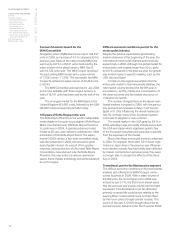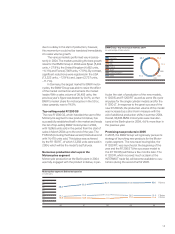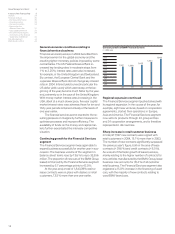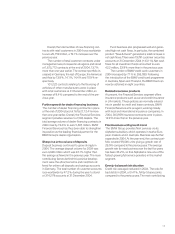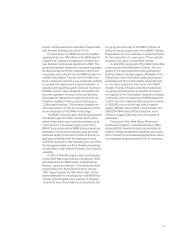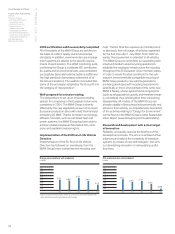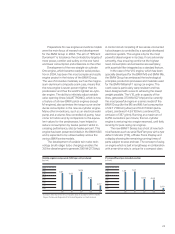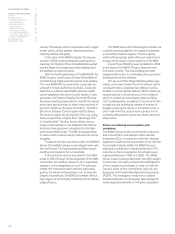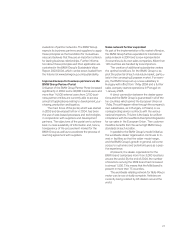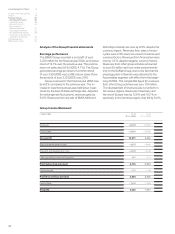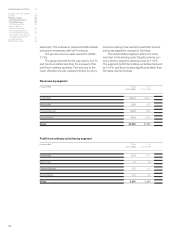BMW 2004 Annual Report Download - page 24
Download and view the complete annual report
Please find page 24 of the 2004 BMW annual report below. You can navigate through the pages in the report by either clicking on the pages listed below, or by using the keyword search tool below to find specific information within the annual report.
23
Preparations for new engines and vehicle models
were the main focus of research and development
for the BMW Group in 2004. The aim of “Efficient
Dynamism” is to balance the contradictory targets of
more power, comfort and safety on the one hand
and lower consumption and emissions on the other.
Development of the new straight-six cylinder
Otto engine, which became ready for serial produc-
tion in 2004, has been the most complex and costly
engine project in the history of the BMW Group.
The use of innovative materials, such as the magne-
sium-aluminium composite crank case, means that
the new engine is seven percent lighter than its
predecessor and thus the world’s lightest six-cylin-
der engine. The ability to infinitely adjust variable
valve opening times (VALVETRONIC), which is now
a feature of all new BMW petrol engines (except
M-engines), also optimises the torque curve and re-
duces consumption in the new six-cylinder engine.
Many other innovations, such as an electrical water
pump and a volume-flow controlled oil pump, have
come to fruition and, by comparison to the equiva-
lent values for the predecessor, have helped to
reduce consumption by twelve percent whilst in-
creasing performance, also by twelve percent. This
engine has been presented initially in the BMW 630i
and is expected to be utilised widely across the
various BMW series models.
The development of variable twin turbo tech-
nology
(multi-stage turbo charging)
enables the
3.0
litre diesel engine to generate 200 kW (272 bhp).
A control circuit consisting of two series-connected
turbochargers is controlled by a specially developed
electronic system. This engine is by far the most
powerful diesel engine in its class. It runs extremely
smoothly, thus ensuring comfort at the highest
level; consumption and emissions are exemplary,
with a particle filter integrated as a standard feature.
In the case of the V10 engine, which has been
specially developed for the BMW M5 and BMW M6,
the BMW Group has embraced the technological
principles, production processes and materials used
for the BMW WilliamsF1 racing car engine. The
crank case is particularly warp resistant and has
been designed with a view to achieving the lowest
weight possible. The V10, with a capacity of five
litres, generates 373 kW (507 bhp) and is currently
the most powerful engine in a series model of the
BMW Group (for the M5 and M6: fuel consumption
of 22.7 l/100 km (urban) and 10.2 l/100 km (extra-
urban), combined 14.8 l/100 km; combined CO2
emission of 357 g/km). Running at a maximum of
8,250 revolutions per minute, this ten-cylinder
engine is venturing into a region reserved, until fairly
recently, for pure racing car engines.
The new BMW 1 Series has a host of new tech-
nical features such as serial RunFlat tyres with a tyre
defect indicator (TDI), a Brake Force Display and
a display showing the remaining running times of
parts subject to wear and tear. The concept of using
an engine which is built in lengthways in combination
with a rear-drive axle, is unique for a compact class
Process effluent per manufactured car
(m3/unit)
1.15
1.10
1.05
1.00
0.95
0.90
0.85
0.80
00 01
1.06 1.07
02
0.94
03
0.93
04
0.79
Volatile organic compounds (VOC) per unit produced
(kg/unit)
4.00
3.50
3.25
3.00
2.75
2.50
2.25
2.00
00
*increase in 2002 due to the new computation basis in accordance with the Volatile
Organic Compounds Regulation (31st Federal Regulation on Gas Emissions)
01
3.21 3.07
02*
3.33
03
2.70
04
2.17



